DOGS IN JAPAN
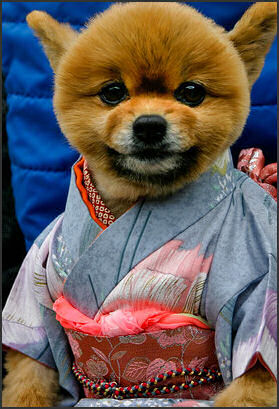
There are 13.1 million pet dogs in Japan, compared to 52 million dogs in the United States. In 2006, 6.63 million dogs were registered up from 3.72 million in 1989. In Tokyo alone, 410,000 dogs were registered on 2005, 1.6 times higher than 1995. In Japanese pet stores, dogs that sell for a few hundred dollars in the United States sell for $3,000 or more.
In Japan, there are two kinds of dogs: small dogs that are allowed in the house and outdoor dogs that have to stay outside and are not allowed inside because of worries that they will dirty the floor or the tatami mats with their feet.
Historically in Japan, animals that didn't hunt, guard the house or kill pests were seen as a luxury in a society that for centuries produced barely enough to feed itself. Economic conditions have changed, however, and cats and small dogs are increasingly common for companionship and even fashion accessories, with a booming market in designer dog clothing and even animal funerals. [Source: Mark Magneir, Los Angeles Times]
The number of dogs has increased as the number of childless women and couples--who often dote on their dogs in place of children--have increased. In 2006 the number of dogs (13 million) exceeded the number of children under 12 (12 million) for the first time. The publisher of a pet magazine told the New York Times, “Households with few or no children are turning to dogs to fill the void.”
In a 2004 survey by a pet food company Japanese households gave the following reasons for keeping dogs (percentage) : 1) they like dogs (69.9 percent); 2) dogs are fun to be around (66.3 percent); 3) dogs are adorable (65.5 percent); 4) dogs enrich daily lives (50.4 percent); 5) dogs are indispensable for family communication (42.1 percent); 6) dogs guard the home (28.7 percent).
Like Britain, Japan has strict quarantine laws for dogs entering Japan for protection against rabies. Even so, of the 13 million or so dogs kept in Japan, only half are believed to have been registered and only 40 percent have been vaccinated against rabies.
Good Websites and Sources: Good Photos at Japan-Photo Archive japan-photo.de ; Blog Report on Dogs in Japan petside.com/petsideblog ; Resident Cards for Dogs gaijinpot.com ; Dancing Dogs reuters.com/article ; Wikipedia article on Hachiko Wikipedia ; Designer Dog Products goodsfromjapan.com
Links in this Website: PETS IN JAPAN Factsanddetails.com/Japan ; EXOTIC PETS, BIRD FIGHTS AND BEETLES IN JAPAN Factsanddetails.com/Japan ; DOGS IN JAPAN Factsanddetails.com/Japan ; DOG BREEDS IN JAPAN Factsanddetails.com/Japan ; ANIMALS IN JAPAN Factsanddetails.com/Japan ;
Love of Dogs in Japan

Japanese love their dogs, sometimes to excessive degrees. Pet loss is the name used to describe depression after a dog dies that results in owners losing the appetite and having difficulty sleeping. A pet cemetery owner told the Yomirui Shimbun, Losing a pet “is like losing a child for some people, and they sob loudly when their pet is cremated."
Tokugawa Tsunayoshi, one of the Tokugawa shoguns, was born in the Year of the Dog in 1648 and felt strongly about the welfare of dogs. Under the Laws of Compassion he made the injuring and killing of dogs, even neglecting them, a crime punishable by death. In 1687 more than 300 people were put to death for violating the laws. Scores are believed to have committed ritual suicide to avoid formal execution.
During Tsunayoshi’s 36 year reign an estimated 60,000 to 200,000 people were either executed or exiled for animal welfare violations. Tsunayoshi once banished a man to an island penal colony for failing to prevent the killing of a sparrow. The men that put the sparrow to death were beheaded.
In 2007, Choco was the most popular name for puppies followed Maaron, names given to brown dogs regardless of sex.
Bow Wow Kingdom — in Moriyama City on Lake Biwa near Kyoto — is an all-dog theme park for humans with 300 dogs from 80 breeds. People pay an entrance fee plus extra for activities such as walking dogs, sunbathing with puppies, belly scratching sessions in the Petting Place. There is a special show featuring dogs riding bikes, walking tightropes, playing ball and rescuing a prince and princess from Bowwow castle.
Dog Feces and Clean Sidewalks in Japan
People in the cities are required to clean up after their dogs. Most bring along plastic bags when they walk their dogs and to pick up their animal’s feces and bring them home and flush them down the toilet. Some people also bring along tissue and wipe the butts of their dogs. David Sedaris wrote in The Guardian, “In Tokyo, I once saw a dog pee on the sidewalk. Then its owner reached into a bag, pulled out a bottle of water and rinsed the urine off the pavement. As for dog feces, I never saw any trace of them.”
In June 2012, the Yomiuri Shimbun reported: “The municipal government of Izumi-Sano, Osaka Prefecture, is considering introducing a tax on dog owners in a bid to reduce dog droppings on the city's streets, it has been learned. Izumi-Sano plans to use revenue from the envisaged tax to set up patrols and educate owners about tidying up their pet's mess, the sources said. Approval from the Internal Affairs and Communications Ministry is required before the tax can be imposed. About 5,400 dogs are registered in the city, which has received many complaints about feces left on the street. If no improvement is seen in about two years, the city will decide on whether to impose the new tax. [Source: Yomiuri Shimbun, June 29, 2012]
“In November 2011, Kyodo reported: “Asako Soma receives an award certificate on behalf of Junior, a 7-year-old male Labrador Retriever, in the town of Naie, Hokkaido. The town government honored the dog for keeping his 81-year-old owner Yoshimasa Soma, husband of Asako, and the man's three -year-old granddaughter Sukai Kimura warm in an overturned car during a freezing night. [Source: Kyodo, November 26, 2011]
Dogs and Meeting People in Japan
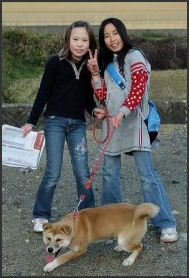
Dog owners often meet with other dog owners in parks. Japanese are often very shy, and they find pets are an easy to meet new people. They often talk to one another through their dogs by asking questions directed toward the pet not the owner.
“Koen debut” is a term used to describe the stressful first visit for a mother and child or for a dog owner and pet to a new park. To make the process go smoothly many pet owners have business cards with pictures of there dogs printed up. A common icebreaking expression is saying how “kawaii” (“cute”) a person’s dog is.
The owner of a dog named Moko told the Asahi Shimbun, “My son didn’t go to a local school, so for a long time we had no friends here. If it weren’t for Moko, we wouldn’t have met our dog-owner friends...Relationships in the big city can be cold and distant. But when dogs socialize with each other, it helps break the ice among dog owners.” She then explain that is why so many people with dogs visit the local park.
In some places it seems like the primary exercise for most people is walking their dog.
Dogs and Meeting Chicks in Japan
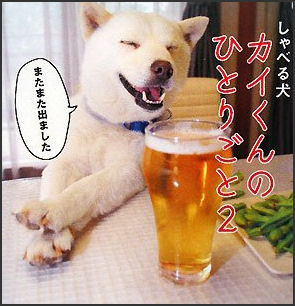
Young men trying to meet girls have found that having a dog is the perfect ice-breaker. Tokyo's Perro Moco pet shop has cashed in on the trend by lending dogs — $50 a day for a poodle, $80 for a golden retriever — to young men. Satisfied customers have said "having a dog generates a lot to talk about" and "grabs their date's hearts."
Rent-a-dog salon, where people spend time with pets in the salon, are popular with unmarried female office workers and double income couples. Customers can rent out pedigree dogs for around $8 to $13 an hour and make requests for a special dog. Miniature dachshunds and Chihuahuas are especially popular.
Puppy the World rents out dogs by the hour, and match clients with pets, and has a rating system that lets customers know which dogs are the most popular or suited for them. Its customers include families with children who live in apartments where dogs are not allowed; lonely old timers who miss their pet dogs; and both young men and young women who want extra companionship. One satisfied customer told The Times of London: “Its just such a perfect way to spend a day. I can walk along with my boyfriend and we can pretend that we own a cute dog together. I would really love to own a dog, but I live with my parents and a even a little one would set off my dad’s allergies.”
Hachiko
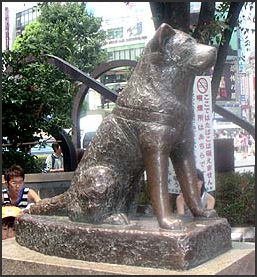
Perhaps the most well known animal in Japan is Hachiko, an Akita that died in 1935 and is now stuffed and displayed at Japan's National Science Museum. "Chu-ken Hachinko, or "faithful dog Hachiko,"was the pet of a Tokyo University professor, Hidesaburo Ueno. Every morning the professor and Hachinko would walk together to the Shibuya station, where the professor would take the train to work and each afternoon at 3:00pm when the professor came home his dog was waiting at the platform to meet him.
Then one day in 1925 the professor suddenly died from a stroke at work. Hachinko waited at the station that afternoon but her master didn't return. She waited again the next afternoon. And the next and the next and kept coming back to the station, every afternoon for the next 10 years.
Efforts to give Hachiko to adopted owners failed. He continued to go to the station and spend his nights sleeping on the steps of the late professor’s house. Even when he was old and lame he continued to show up at 3:00pm at the station. He was cared for by the professor’s gardener and a stationmaster at the station, often begging for food from the numerous street vendors in the area.
Hachiko's devotion caught the imagination of the world. Articles were written about him inside and outside Japan. The Los Angeles Friends of Animals was so moved it raised money for a statue of the faithful dog that was erected in Shibuya Station in 1934, a year before Hachiko died. Replicas of the statue were given to schools all over Japan. Though his body was put on display at the National Science Museum near Ueno Station in Tokyo his bones were interred with those if hit master in Aoyama cemetery.
Hachiko Legacy
Everyone in Japan knows Hachiko. Children are read bedtime stories about the faithful dog and teenagers in Tokyo often say "Hachiko “mae de”!" ("Let's meet at Hachiko"), a reference to the teenage hangout and entertainment district of Shibuya, where the dog used to meet his master.
In 1936 the Hachiko story was included in the moral education textbooks for primary school as an illustration of loyalty and fealty to a master, encouraging loyalty to Emperor Hirohito. During World War II, Japan's military dictators made Hachiko's story mandatory reading in school even though they ordered her statues melted down so the metal could be used in shipbuilding.
Jesse Glass, a professor at Meikai University in Chiba, told the Daily Yomiuri: “The story of Hachiko is particularly appealing to the Japanese because the high value that Japanese culture traditionally places on fealty to the group, boss or master — eve if the mast master is absent in death.” Cynics speculate that maybe it was handouts from yakitori vendors not loyalty to his master that may have kept of Hachiko coming back — a number of wooden skewers were found in his stomach after he died.
Today Japanese can choose from hundreds of books, movies, compact discs, statues and plaques honoring Hachiko. He has been commemorated on a postage stamp. Department stores sell a $50 Hachiko necktie with "Wan Wan" printed on it and a $58 wristwatch with the English message on the dial: "The most heartful and Japanese, a dog. He goes to station to meet” In 1994, the Year of the Dog on the Chinese lunar calendar, the Culture Broadcasting Network broadcast a newly discovered recording of Hachinko's bark. [Source: T.R. Reid, the Washington Post]
Dog-Related Businesses in Japan
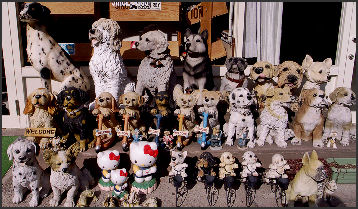
Dog-related businesses are among the most common local neighborhoods businesses. It is not uncommon to have several dog salons, veterinarians, dog food stores, a couple pet hotels and even dog restaurants within a couple blocks of one’s home.
The are dog shrines for owners who want to be accompanied by their dogs when they pray. There are special swimming pools and trainers used to rehabilitate dogs that have endured some kind of accident. In the early 2000s, it became popular for apartment dwellers to transform their roofs into gardens for their pets. Elaborate ones cost $20,000 or $30,000 and have shade trees, scratching pads and climbing equipment.
There are daycare centers for busy people who can’t take of their dogs during the day and nursing homes for elderly or infirm dogs. Dogs Day Care of Japan charges a ¥21,000 admission fee and ¥310,000 for three months for small dogs. The fees cover transportation, meals, trimming and health management expenses. During the day the dogs play indoors and employees take them for walks. Pet Resort Colleges offers to take “responsibility for caring for a pet to the end” for a deposit of ¥300,000 and of a fee of ¥1.5 million for a small- or medium-size dog of the age of eight years old. Customers receive a photo of their pet every month and can visit their pet whenever they like.
Dog businesses also have their ugly side. One breeder of costly dogs murdered four of his clients after disputes over the sale of dogs.
Dog Hotels, Restaurants and Beauty Salons in Japan
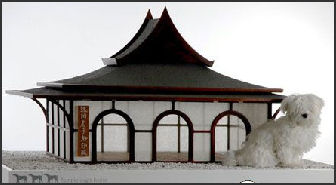
In Japan, you can find hotels and spas for dogs. For a $20,000 membership fee, dogs can join the Athletic Dog Club in Tokyo, where they can take etiquette classes, and participate in a weight-gain or weight-loss programs. When beloved pets pass on, their owners can spend up to $8,300 for a deluxe funeral and cremation ceremony.
There are spa resorts that offer special baths for dogs and floss and manicure services and can dress up the dogs in special New Years outfits. Some beauty salons for dogs offer body massages using scented oils, deep pore cleansing with mud packs and relaxing bubble baths. An owner of one spa told the Asahi Shimbun, “Up till now, people sought comfort from their dogs. Nowdays, owners feel the urge to give comfort to their dogs.”
There are special restaurants in which pets can sit on chairs on eat prepared meals on a table with their owners. The Three Dog Bakery prepares special meals for dogs with eating disorders and sells dog cakes and biscuits made without preservatives. Printemps Ginza department store sells handmade dog food, special bento boxes for traveling dogs, Montblanc cake made with carrots and pumpkin pudding. Special New Year dishes and dog food cooking classes,
Pet beauty saloon in Tokyo offer shampoo, claw cut and ear cleaning for $60; deluxe haircuts for $150. It is not unusual for poodle owners to spend $200 twice a month to get their dogs trimmed and shampooed. There are even dog laundromats where you put your pet through a spin and dry cycle.
Printemps Ginza department store offers 10,000 items of dog clothes including fake fur coats, kimonos and Halloween costumes and a photo service in which a dog can be photographed in a Santa suit. The OwnD café in Yoyogi-Uehara, Tokyo has an oxygen bar for dogs with metabolic syndrome and a special service in which dogs are placed in an airtight cylinder into which oxygen is pumped at 1.2 times the normal pressure to simulate the affects of aerobic exercise. The service cost ¥2,100 for 30 minutes,
Designer Dog Products in Japan
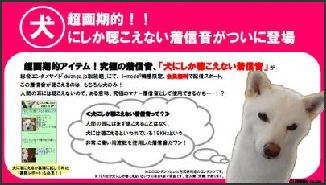
dog ring tones It is not unusual for Tokyoites to spend $1,000 on accessories for their dogs in the Ginza district. Dog-owners seem to lavish their pets in this way whether the economic times are good or bad.
Japanese not only buy sweaters and jackets for their dogs they also buy $350 Burberry trench coats and $1,500 Hermes leather tote bags for them. Gucci dog frisbees that sell for $600 were so popular after they were introduced that stores had trouble keeping them in stock. Prada, Tiffany, Coach and Louis Vuitton all offer products for dogs in the Japanese market. It also possible to get tailored kimonos with family crests for dogs. Some poodle owners buy matching Hermes dog collars for their pets and handbags for themselves.
Dog owners can also buy devices that measure "levels of emotions” in their pet's voice and magnetized collars that are said to increases a dogs circulation and stimulate appetite and reduce stress. There are also aromatherapy oils, hair sprays, conditioners, bath salts, perfumes, workout machines, contact lenses, tofu treats, counseling, Alzheimer disease remedies and nonalcoholic champagne for dogs.
Bowlingual is a device made by Takara Company that “translates” dog barks into human speech. Selling for $120, it consists of collar with a microphone and a hand held receiver which processes the barking sound into text. Over a 150,000 of the devices were sold in first year on the market. An English version was rushed to the American market. A journalist who tried one got “Why don’t you understand?” with a persistent bark and “Have you forgotten about me?” and “I’m blue and I want to cry? with a whimper. Secom, a home security company, make a GPS tracking devise for dogs. Customers pay a registration fee of $45 and a monthly fee of $5.
Some pets have identification chips (IC) tags inserted into them that give the name and contact details of the dog owner and other information. The tag is in a capsule two millimeter in diameter and 13 millimeters log, which is injected under the animal’s skin and is read with a special hand-held device.
Owners of old dogs routinely spend hundreds of dollars a month on medical bills for their aging pets. There is a market for special diapers, hot springs, food, even wheelchairs for pets. At some veterinary clinics pet owners can chose between Western medicine and Oriental medicine treatments. Other clinics offer acupuncture for pets.
The Tokyo-based Japan Pet Model Association is a modeling agency for pets was launched in 1997. More than 70 percent of its members are dogs; 2 percent are cats and the remainder are small animals such as rabbits, There is also a talent agency for dogs called Idol Dog Club 1111 that is run by a management company for singers and musicians.
Designer Dogs in Japan
Carefully-bred dogs such as chihuahuas with a blueish tint and teacup-size poodles small enough to fit into a purse and dachshunds with white skin are sought after and can fetch prices of $10,000 or more. Many are pampered and displayed as if children of proud parents. The publisher of a dog magazine told the New York Times, “For a dog to be part of the family it has to be unique and have character like a person.” [Source: Martin Fackler, New York Times, December 2006]
Some of these dogs come from inbred parents and litters with siblings with missing paws and missing eyes. There have been cases of puppies born with bones that are so soft they dissolved in their bodies, eyes that wander aimless in their sockets. and brain disorders that cause dogs to spend all day running in circles.
Dogs have traditionally been carefully bred with dogs with similar genetic make up to bring out desirable recessive traits but in Japan caution is often thrown to the wind as breeders tried to make a quick buck by breeding siblings and parent to produce the recessive traits quickly and in large numbers. The breeding industry is largely unregulated. There are laws on the books that revoke the licenses of breeders who breed dogs with birth defects but there are only four officials monitoring 25,000 pet shops, kennels and breeders in Japan.
The New York Times interviewed a pet shop owner that was taking care of a half white dachshund with wandering eyes that came from a dog that had been bred with a daughter then a granddaughter and then a great granddaughter to bring out the desired white skin. The other member of the litter were so disfigured they were killed after birth.
Researchers Study Whether Dogs Like Hot Springs
In January 2012, the Yomiuri Shimbun reported: “Are hot-spring baths as relaxing for dogs as they are for humans? A research team from a professional training college in Okayama City is looking into the matter. Dogs unaccustomed to bathing in hot springs do exhibit signs of stress, but appear to relax again as they become more familiar with the activity. [Source: Yomiuri Shimbun, January 8, 2012]
Okayama University of Science Specialized Training College, a vocational training school for animal health technicians, conducted the study at Yubara hot spring in the city of Maniwa, Okayama Prefecture, from May 2010 to October 2011 with help from the Maniwa City government and an association of inns and hotels in the former Yubaracho area, now in Maniwa. The group intends to study better ways for dogs to bathe in hot springs.
The study group placed seven dogs, including border collies, in a dog-only hot spring facility for 15 minutes to measure changes in body temperature and amylase concentrations in their saliva. Amylase, a digestive enzyme, was used as a barometer to gauge stress. They found that the dogs' body temperatures rose by 0.2 C while bathing in the hot spring, and that their bodies would retain heat for one hour after bathing. When the dogs were in the bath, amylase concentrations increased to about twice their pre-bathing levels, but returned to normal levels 15 minutes later.But once the dogs got out of the hot spring, amylase concentrations were triple that of normal levels, returning to normal after 50 minutes.
The research team believes the levels first rose because the dogs were bewildered by a new environment, dropping once the dogs became familiarized and relaxed. The team also believes the dog's stress levels increased after bathing due to the noisy hair driers researchers used to dry the dogs. Naoko Minami, an animal health technician and an employee at the vocational training school, said, "We still can't explain clearly the effect of hot spring water on dogs, but [we can say that] it's best to bathe dogs in a hot spring at times when they feel less stressed." Minami advised bathing dogs in hot springs after a 30-minute rest period, as a lengthy car drive to a spring can be burdensome for dogs.
Dog Rescues and Dog Education in Japan

In November 2006, a team of 17 rescue workers was mobilized to save a dog trapped for six days 70 meters off the ground on a concrete wall on the side of the cliff. After an effort to catch the dog failed it was pushed off the ledge into a safety net hanging below and was rescued emaciated but unhurt.
Japanese dog-owners are becoming increasingly worried about the poor behavior of their pets. In Tokyo, the local government has stepped in to provide dog-owners with handling manuals on information on dog-training classes. The government has also taken action to educate dog owners on polite behavior from their pets and provide them with free bags to pick up their dog droppings. One ward has a staff of “dog life councillors” to talk with owners of unruly pets and provide owners with tips on how to improve their behavior on matters like scavenging for food, barking at night and attacking small children.
In February 2011, a seven-year-old Chihuahua named Momo passed the test to be a part time police dog in Nara Prefecture and was given a 11.5-centimeter-long, navy-blue police jacket to show his status and achievement.
Dog Excels at Sniffing out Cancer
According to a Kyodo release : “A specially trained dog sniffed out biological samples from cancer patients over those of healthy people with at least 90 percent accuracy, according to a team of researchers. The findings by the team, which includes researchers at St. Sugar Cancer Sniffing Dog Training Center in Minamiboso, Chiba Prefecture, and Hideto Sonoda, an assistant professor at Kyushu University was published in the U.K. medical journal GUT.” [Source: Kyodo, January 30, 2011]
“In the experiment between November 2008 and June 2009, the researchers got the 9-year-old female Labrador retriever named Marine to sniff samples taken from about 300 people. In a test using five containers with breath samples, Marine correctly chose a sample taken from a patient with colon cancer 33 out of 36 times, they said. In another test using liquid taken from feces, she chose the correct samples 37 out of 38 times, they said.”
“Marine's training included getting her to recognize ingested food from the breath of a person in the belief she might be able to sniff out a disease based on odors inside the body, said center chief Yuji Sato. The dog also succeeded in sniffing out cancer of the breast, stomach and prostate, Sonoda said. “She presumably reacted to a smell unique to cancers,” Sonoda said. “If we can identify the material causing the smell, it may lead to early cancer detection.”
In April 2012, the Yomiuri Shimbun reported: “A 10-year-old Labrador retriever has been trained to detect gynecological cancer such as uterine cancer with a high level of accuracy. Marine, a female, was trained in Minami-Boso, Chiba Prefecture, to detect smells specific to cancer, said Masao Miyashita, a professor of Chiba Hokuso Hospital of Nippon Medical School. Marine has also begun using her training to successfully detect cancer of the large intestine. Experiments are now under way to see if she can also detect stomach and breast cancer. [Source: Yomiuri Shimbun, April 26, 2012]
“In the experiments, Marine walks with a researcher in front of boxes that contain test tubes filled with one milliliter of urine. If she smells cancer, she sits down in front of the box. If not, she walks on. Marine detected cancer from the urine of all 43 patients who suffered from five kinds of gynecological cancer such as uterine, cervical and ovarian cancer."She can detect symptomless early-stage cancer," Miyashita said. "We'd like to determine the substance she smells and improve technology for early detection." Among 29 patients who suffered from noncancerous gynecological diseases such as uterine fibroid, she mistakenly identified one cancer-free patient as having cancer.
“In the experiments on cancers of the large intestine, breath samples were used instead of urine. A Kyushu University research team confirmed that Marine could detect this kind of cancer with an accuracy of more than 90 percent. This study was published in a British medical journal in January last year. Miyashita said the experiments for stomach and breast cancer are progressing smoothly. He said his team plans to present the research at conferences of the Japanese Breast Cancer Society in June and the Japanese Cancer Association in September.
Dogs on Japanese TV and Film
Wm. Penn wrote in the Daily Yomiuri in January 2011: “Is TV going to the dogs? It certainly is. Canines seem to be the only TV stars winning the public's heart of late. No wonder NTV chose this season to give us the dramanga “Deka Wanko“ . It's quite entertaining if you like police dogs, an actress decked out in Angelic Pretty fashions pretending to be one, and camp parodies of the detective drama genre set to the Taiyo ni Hoero theme song. Ichiko Hanamori (Mikako Tabe) is a rookie police detective. (The kanji for Ichiko can also be read Wanko, thus the "dog detective" nickname.)
“Wanko has a nose to rival a basset hound and can sniff out a culprit in no time. She never forgets a scent. Her only rival is Mihail, a German shepherd police dog. A promising comic talent, Tabe does admirably with a role that requires nothing much but sniffing and dressing in fantastically frilly costumes — all ruffles, lace, and funny headgear. If you are unfamiliar with the cutesy Japanese lolita fashion look, Deka Wanko is definitely worth a glance and a few chuckles.”
In 2010 a film called “Wasao” was made about a white akita by the same name. An expansion of a popular television show, the film was about a an “ugly but cute” dog that was abandoned and taken in by a woman who runs a broiled squid shop. The dog later was named special ambassador for World-Heritage-related activities and appeared at tree-plantings and other events.
World's Oldest Dog Dies in Tochigi Prefecture
In December 2011, the Yomiuri Shimbun reported: “The world's oldest dog has died in Sakura, Tochigi Prefecture, at the age of 26 years eight months--equivalent to 125 human years--his owner said. Pusuke, certified by Guiness World Records as the world's oldest living dog last year, died at his home, owner Yumiko Shinohara said. Pusuke is believed to have died of old age. [Source: Yomiuri Shimbun, December 8, 2011]
“The dog was born at the home of one of Shinohara's relatives in March 1985 and was registered as a pet on April 1 that year. In 2008, he suffered serious injuries after being hit by a car. A vet told Shinohara it would be difficult to save Pusuke's life, but the dog underwent successful surgery. In December 2010, Pusuke was certified by Guinness World Records as the world's oldest living dog, breaking the previous longevity record of 21 years three months.
“According to Shinohara, Pusuke's physical condition took a sudden turn for the worse. The dog did not eat breakfast, which had never happened before, and died quietly at about 1:30 p.m., surrounded by Shinohara and her family.Shinohara, 42, said Pusuke looked fine and normal until the previous day."I was with Pusuke for 26 years and I felt as if he was my child. I thank him for living so long with me," Shinohara said.
Image Sources: 1) Andrew Gray Photosensibility 2) Japan-Animals blog 3) 5) 6) 9) Ray Kinnane 4) Hector Garcia 7) 8) xorsyst
Text Sources: New York Times, Washington Post, Los Angeles Times, Daily Yomiuri, Times of London, Japan National Tourist Organization (JNTO), National Geographic, The New Yorker, Time, Newsweek, Reuters, AP, Lonely Planet Guides, Compton’s Encyclopedia and various books and other publications.
Last updated January 2013
